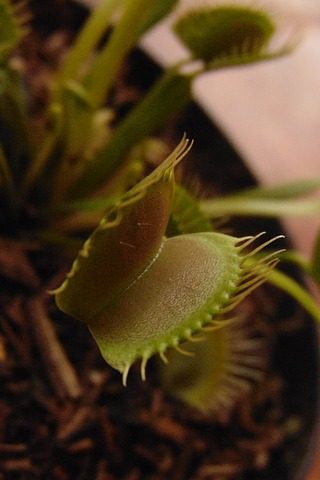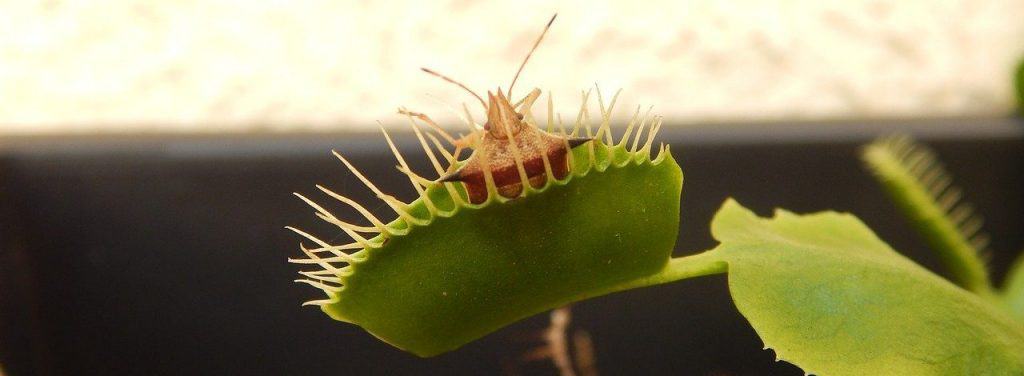Several wild plants are safe to be eaten by humans, but what about Venus flytraps? Are they edible? In this article, we will cover some interesting details about Venus flytraps and determine if they are a suitable emergency meal.
Venus flytraps are edible. They are not poisonous plants, and their consumption does not impose any type of risk to humans or pets. However, it is not recommended to consume Venus flytraps since they are an endangered species. Other plants are better suited for a balanced human diet.
We just learned humans could consume Venus flytraps. But, does it make sense to eat Venus flytrap? And what do Venus flytraps eat anyways?
Are Venus Flytrap Edible?
When you buy indoor plants, an important consideration is if they are safe to eat. The question doesn’t usually arise from the desire of eating your new plant, but due to the presence of curious kids and pets.
You will be surprised by how many house plants are poisonous. You can read this article and review an extensive list of poisonous indoor plants. The list even includes the Photos plant and the Tulip! However, Venus flytraps are a different story. They are not toxic, and they are edible. So, they can make a great indoor plant, and they do not pose a risk to pets or curious kids.

Venus Flytraps can be consumed without any issues, and you can touch it without any risk of rash or infection. Some people are scared about handling Venus flytraps because of their jaw-looking leaves. But, Venus flytrap can not harm humans.
Even if you put your trap inside a trap and activate it, your finger will be ok. You will barely feel it. Those traps are not designed to bite, but they are designed to capture tiny bugs.
In reality, Venus flytraps have a much better chance of being harm by humans than the other way around.
Where to Find Venus Flytrap
Venus flytraps are a very peculiar species. They grow in the wild in only a few locations.
Venus flytraps are native to South Carolina and North Carolina in the United States. There they grow in only two regions: the coastal plain and sandhills.
Coastal Plain: They are a flat and low-lying piece of land next to the ocean. They are separated from the rest of the interior by nearby landforms, such as mountains or hills.
Sandhills: They are an inland habitat type characterized by rolling hills with a thick capped by deep coarse sands. They are wedged between the Coastal Plain and Piedmont regions.
In their natural habitat, the Venus flytrap lives in very poor soil, which lacks nutrients. Also, there they have access to plenty of light and a humid environment. Due to the lack of nutrients in the ground, Venus flytraps developed trapping mechanisms to capture and consume prey. Even though capturing prey is not crucial for their survival, Venus flytraps benefit from consuming a bug every now and then.
Encountering carnivorous plants in their natural habitat is a very memorable experience. For Venus flytrap, however, it is difficult to accomplish as they only live in a small region of the United States.
The Venus Flytrap Is Endangered
Even though we can consume Venus flytraps at no risk, you should avoid harming Venus flytraps. The Venus flytrap is an endangered species. About ten years ago, it was added to the endangered species list.
Many factors are affecting the Venus flytrap natural habitat and have led to a wild population decrease:
- Poachers
- Environmental changes
- Urbanization and agricultural expansion
Poachers
Poachers remove plants from their natural habitat and sell them for profit. Poaching Venus flytraps is illegal (it is a felony in five North Carolina counties), yet it is still a common practice.
Environmental Changes
Due to global warming and climate cycles, the natural habitat of Venus flytrap has changed dramatically during the past decades. Temperatures in the Carolinas reach more extreme levels, and there had been an increase in tropical storm and hurricane exposure.
Urbanization and agricultural expansion
Cities have expanded and now occupy the previously untouched territory where Venus flytraps lived. Also, the expansion of agriculture has taken over large amounts of land and reduced the number of wild species.
Fun fact: The Venus flytrap is North Carolina’s state carnivorous plant
As a way to promote the preservation of the species. North Carolina declared the Venus flytrap their state carnivorous plant in 2005. North Carolina is the first state to declare a carnivorous plant as a state symbol.
If you ever encounter a Venus flytrap in the wild, admire it as much as you can, but do not attempt to remove it. There is no need to remove Venus flytraps from their natural habitat. Instead, browse online or at your local nursery for responsibly grown Venus flytrap.
We all need to wok together in preserving this fascinating specie of carnivorous plants.
Where to Get a Venus Flytrap
The Venus flytrap is endangered, but you can still own a Venus flytrap without harming the wild population. Breeders all over the world propagate and sell different varieties of Venus flytrap.
You can buy a Venus flytrap at your local nursery (if they carry carnivorous plants), online, or in brick and mortar stores. Preferable, buy Venus flytrap from reputable sources and when in doubt ask how do they propagate their plants. They should be able to give you a detailed answer.
You can learn more details about where to buy Venus flytrap with this article: Venus Flytrap Shopping Guide. Also, make sure to review the Venus flytrap care instructions before you own one
What Do Venus Flytraps Eat?
Humans and animals could consume Venus flytrap. But how does it work the other way around? What do Venus flytraps eat?
First, like most plants, Venus flytraps produce their own food via photosynthesis. Second, Venus flytraps capture prey to supplement their diet and gain key nutrients.
Venus flytraps are carnivorous plants. Their leaves have evolved over thousands of years to be capable of capturing prey. The Venus flytrap is a small plant, it can reach a height of a foot tall, and the size of an adult trap barely exceeds 1 inch.
The traps are designed to capture insects and arachnids, however, Venus flytrap can capture many other beings. For example, they can capture and consume tiny frogs, mice, or even birds. In the end, they are carnivorous plants, not insectivorous plants.
Venus flytraps can consume meat, but the event when this occurs is very unlikely. The vast majority of times their diet relies solely on insects and arachnids.
Fun fact: Venus flytraps not only eat flies
Venus flytraps eat crickets, beetles, grasshoppers, spiders, slugs, ants, worms, and of course, flies. As long as the prey is small enough to fit inside the trap, the Venus flytrap will attempt to capture it.

Could a Venus flytrap eat a human?
Technically, yes Venus flytrap can consume a human, but only parts of it. Venus flytraps can consume flesh, but due to their size and resilience limitations, they can only consume very small pieces. Also, the digestion process takes a long time.
The Venus flytrap takes a week or two to digest a single bug. So, yes, Venus flytrap can eat meat, but it is unfeasible to think Venus flytrap can consume a large mammal.
Related Question
What happens if a human eats a Venus flytrap?
Probably nothing besides a stomachache. Venus flytraps are not poisonous to humans; you shouldn’t expect any type of allergic reaction.
Still, Venus flytraps do consume bugs and they hold them inside their traps for several days to complete the digestion process. If a human or pet consumes a Venus flytrap which was digesting a bug, then they will be consuming the bug too.


